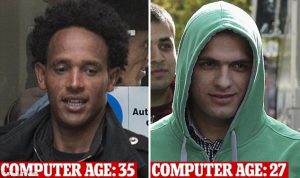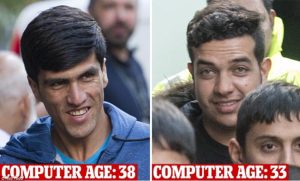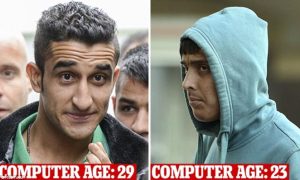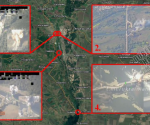Does the adult “child refugee” travesty continue; any connection to Parsons Green?
There has been a development in the Parsons Green so called “bombing” incident since the last article that appeared on the subject at FBEL. It has its own interest as a stand alone item, but it is eminently more intriguing when one simultaneously tangles with two other issues that are also happening right about now.
Newly released figures show that 425 people, who were there in the capacity of ISIS fighters, have returned to Britain from the “dwindling caliphate” in Iraq and Syria. The source of the figures is something called The Soufan Centre, which of course gives the British state security apparatus plausible deniability; when this sort of data is collected by a private intelligence gathering operation then everyone involved can pretend that
there are fears many [ISIS fighters] have “disappeared” from the view of security services, who will not publicly confirm how many returnees have been jailed or are being tracked.
To help us appreciate the form by which we should have faith in the integrity of anything coming from any Establishment mouthpiece, the Independent, from whence the above quotes come, repeats the big lie that Salman Abedi was intrinsically linked with ISIS (he was connected with the LIFG, which the British authorities allow to live in Manchester). One would have to be very naïve indeed not to realise that the point of releasing this data is to make the prospect of terror attacks in the UK more plausible in the feeble minds of the sheeple – therefore ultimately it must come from those supposedly reticent security services. The talking point that arises is not what should be the obvious scandal (we’ll get to this shortly), but instead it revolves around what treatment that these returnees should expect now that they are back on UK streets. Some people offer a hard core option, which no one should take seriously because it is presented in order to be the unreasonable strawman in contrast to a less shocking alternative. This is from one-time Bilderberg Group attendee Rory Stewart (as quoted in the Independent piece), presumably just doing what is expected of him:
They are absolutely dedicated, as members of the Islamic State, towards the creation of a caliphate, they believe in an extremely hateful doctrine which involves killing themselves, killing others and trying to use violence and brutality to create an eighth century, or seventh century, state… So I’m afraid we have to be serious about the fact these people are a serious danger to us, and unfortunately the only way of dealing with them will be, in almost every case, to kill them.
Of course, this input triggered the “send ‘em to social services” side of the argument, which is supposed to win the debate. This is how the system works.
The whole returning ISIS fighter narrative naturally needs some basis of “fact” or else people just aren’t going to believe that a multi-million dollar security apparatus can’t look at passports and ask a few questions at a limited number of points of entry into a country surrounded by seas, and that is why the Independent leans further on The Soufan Centre (whose website was created in 2016 – just in time for managing perception of the demise of the caliphate):
Research found that not all Isis fighters may be able or willing to return to their home countries, and may travel instead to the group’s emerging bases in Afghanistan, Libya, Egypt and the Philippines.
If one reads the reports from Syria (see Southfront.org), most ISIS fighters in the East of the country where the group is generally found – if they survived the fight with the Syrian-Iranian-Hezbollah-Russian alliance – will have escaped via a deal with the US/UK-supervised SDF. Some would have been important enough to get helicopter-lifted out of whichever tricky situation they were in. And so, if we are going to believe that ISIS fighters find themselves wherever they are in the world because of unilateral decision-making, then we’d also have to marvel at the miracle of how they all manage to pitch up to the exact same hotspot that happens to coincide with the current US/UK target for destabilisation. The movement of ISIS, or any mercenary group whatever its current title for the purposes of media smokescreen, is not a casual affair dependent on the whims of individuals. Who can forget the ship carrying mercenaries to Tripoli – on board which the men remarked about going to Syria next? We should strongly suspect that people from the UK who were in Syria to fight for ISIS were deployed there by the British Government – and that should be the scandal as mentioned above.
Of course, getting one’s own boys back should be a doddle, but let us, dear reader, war-game about what would have to be done in order to redeploy an asset into Britain, and to a location whereby he could be found later for further duties, who had been recruited in the field? This person wouldn’t have official documentation, so he couldn’t just be waived through at customs. So, what about getting these characters in through the refugee system?
In 2016, as the reader may know, the British Government produced something called the “Dub Amendment”, which involved a waiving of the rules so that a number of unaccompanied child refugees could be taken out of the infamous camp at Calais known as the “Jungle”. There was immediate scandal when the first batch arrived, stubbled and swarthy, and looking nearer 30 years old than 13. It is a wonder how the Home Office could have been as surprised as it appeared to be; it was a surprise that could have been measured exactly in proportion to the reaction that the public outrage elicited, which was to build a huge fence around the building that would process these “children” so that there could be no further exposure of what was an operation in mockery of public trust. It turned out that in the year to September 2015, two-thirds of all unaccompanied child refugees into the UK had, under questioning, been exposed as being adults.
The Daily Mail, on the face of it doing something useful for once, showed its audience the results of “computer analysis” – presumably using facial recognition technology – of images of some of the “children” who were amongst the first lot to come from Calais under Dubs. The author has inserted into this page as many as he could find: see below.
No wonder the Home Office wanted the big screen in quick order – along with the efforts of TV personality Gary Lineker to shame the evil tax payers into not being angry about being taken for mugs (for all the ridicule aimed at him, Jimmy Hill would have never been such a useful tool). But the Mail reported a detail that seemingly absolutely justified the general public in its ire: one of the children was already on the British biometric database, and he was known to be older than 18. The Mail reasoned that the situation meant one of two things: “he… tried to enter Britain before or has a criminal record”. How does an individual who never set foot in the country before have a record of any sort? Is it possibly anything to do with the fact that the records don’t tell the full story? The Mail also reported that it understood that this individual could have been allowed to remain despite all the glaring problems. It all made it look as though the British Government was banged to rights, but it is more likely that on being discovered, the operation was swiftly converted into a psyop.
In July there was news that not a single “child” has been moved to Britain under Dubs in 2017. Naturally, MPs have been expressing their frustration and dismay at this. However, the author has reason to understand that young men, who are from the Middle East and in the care of social services, are newly applying to certain benefits outlets to claim funding. Moreover, it appears that what could be genuine cases of “Dubs children” are just plain forgotten about. And so the author suspects that the Dubs scheme became a strawman which, in the full glare of the publicity given to it by usually faithful corporate-media, could be smashed up and sacrificed, and thereafter public attention could be guided to a closure moment; i.e. the announcement that the scheme no longer operates. Meanwhile, the Government would be bringing “children” in on the quiet?
 And so we come to Ahmed Hassan, the 18 year old who was arrested for the “bombing” on the tube train at Parsons Green. Two months later, and there is still no photographic image of him in the public domain. This is not to say that there has been no limited offering whatsoever; back in October a court drawing (inserted on the right) was published by some propaganda outlets showing an individual, purported to be Hassan, appearing at a pre-trial hearing at the Old Bailey via a video link from a location purported to be Belmarsh prison – according to details in the image itself.
And so we come to Ahmed Hassan, the 18 year old who was arrested for the “bombing” on the tube train at Parsons Green. Two months later, and there is still no photographic image of him in the public domain. This is not to say that there has been no limited offering whatsoever; back in October a court drawing (inserted on the right) was published by some propaganda outlets showing an individual, purported to be Hassan, appearing at a pre-trial hearing at the Old Bailey via a video link from a location purported to be Belmarsh prison – according to details in the image itself.
There was previously great incredulity at FBEL about the apparent sudden malfunction by the British security apparatus whereby the face of the enemy hadn’t been produced in corporate-media for the purpose of inducing a hate-fest. There is very likely a technical manual in the possession of high-ranking police and media explaining the crucial importance to the psychological impact of “terror” to have the public identify the culprit. And yet we only have two court drawings.
Naturally the question arises: what is it about this case that means that the playbook is defunct? We do know that Ahmed Hassan was an “orphan” from Iraq who was living with foster parents – although he was 18 when he was arrested (as it clearly states here). The first piece of information suggests that he was an (unaccompanied) child; the second that he was old enough to be a criminally responsible adult. The first piece of information suggests that we might expect him to be afforded some confidentiality; the second piece suggests that we should not expect anything of the sort. The least we can say about this is that it represents the lengths to which the British Government is now going to obfuscate any clear apprehension of the issue of the legitimacy of a certain section of the UK’s migrant population. Could it be that Ahmed Hassan wouldn’t look like an 18 year old in any photograph that the British Government could produce?






















